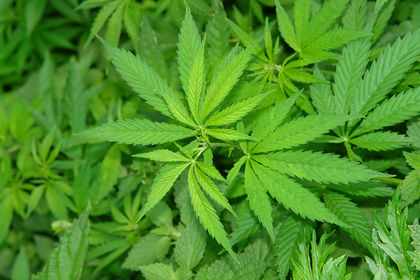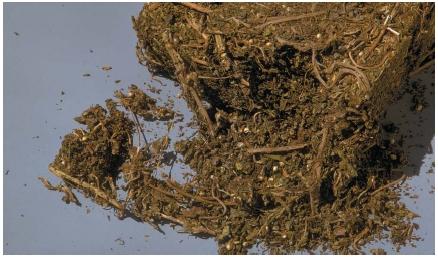Marijuana

Marijuana is the common name for the drug obtained from the hemp plant, Cannabis sativa. Hemp is a tall annual plant that can grow in almost any climate. Native to central and western Asia, hemp is one of the oldest crops cultivated by humans. Hemp's most common agricultural use has been as a source of linen, rope, canvas, and paper.
Hemp contains more than 400 chemicals. The main psychoactive (affecting the mind or behavior) chemical is tetrahydrocannabinol, commonly referred to as THC. For over 3,000 years, the dried ground leaves, flowers, and stems of the plant have been smoked, eaten, chewed, or brewed as a medicine to relieve symptoms of illness. From the seventeenth to the early twentieth century, marijuana was considered a household drug useful for treating such maladies as headaches, menstrual cramps, and toothaches.
In the 1920s, as a result of the Eighteenth Amendment to the U.S. Constitution forbidding the manufacture and sale of alcoholic beverages (Prohibition), the use of marijuana as a psychoactive drug began to grow. Even after the repeal of Prohibition in 1933, marijuana (along with morphine, heroin, and cocaine) continued to be widely used. In 1937, 46 states banned the use of marijuana.
In 1985, the Food and Drug Administration (FDA) gave approval for the use of two psychoactive chemicals from marijuana to prevent nausea and vomiting after chemotherapy in cancer treatment. Medical researchers also propose using marijuana to ease the effects of glaucoma (a serious vision disorder), as a bronchodilator (a drug that helps open the bronchial air passages in the lungs), and as an antidepressant.
The origin of the word marijuana is not known, but it appears to be a combination of the Spanish names Maria and Juana (Mary and Jane). The drug slang for marijuana includes such names as Mary Jane, pot, grass, herb, tea, reefer, and weed. Hashish is the highest grade of marijuana. It is made from the resin found on flower clusters and top leaves of the female hemp plant.
Words to Know
Cannabis sativa : The botanical name for the hemp (marijuana) plant.
Dopamine: Brain chemical responsible for causing feelings of reward.
Glaucoma: An eye disease that seems to be helped by the main psychoactive compound in marijuana.
Hashish: A more potent form of marijuana that comes from the flower clusters and top leaves of the female hemp plant.
Prohibition: Eighteenth Amendment to the U.S. Constitution that prohibited the use and sale of alcohol.
Psychoactive drugs: Drugs that contain chemicals that effect the mind or behavior.
Tetrahydrocannabinol (THC): The main psychoactive compound in marijuana.
Effects
The effects of marijuana on a user change dramatically as the dosage increases. Taken at low doses, marijuana tends to make a user drowsy and relaxed. The user may also feel a general sense of well-being. As the dose increases, a user may experience an altered sense of time and awareness, and may have difficulty completing thoughts and taking part in conversation. A user's sense of balance and short-term memory (remembering very recent events or from one moment to the next) may also be affected. At higher doses, severe psychological disturbances can take place, such as paranoia, hallucinations, and panic attacks.
Marijuana affects the cardiovascular system by increasing heart rate and dilating (expanding) blood vessels in the eyes. Difficulty in coordinating body movements and pains in the chest may be other effects of the drug. Scientists believe that long-term use of marijuana damages the lungs in a manner similar to tobacco smoking.
Scientific studies released in mid-1997 indicate that people who smoke large amounts of marijuana may experience changes in their brain chemistry. These changes are similar to those seen in the brains of people who abuse addictive drugs such as heroin, cocaine, nicotine, and alcohol.
All addictive drugs increase the amount of dopamine in the brain. Dopamine is a brain chemical responsible for causing feelings of reward. The new studies found (for the first time) that high doses of marijuana increased the levels of dopamine in the brain. Constant use of addictive drugs, however, can cause the brain to lose its ability to produce high levels of dopamine. When this happens, a drug user feels a greater need for the drug, or for even stronger drugs. Scientists believe this may occur with marijuana.
Users of addictive drugs feel withdrawal symptoms (feeling anxious, edgy, and unable to cope) when they stop taking the drugs. It was previously believed that marijuana users did not suffer feelings of withdrawal. However, the recent studies indicate that heavy users of marijuana smoke not so much for the "high" but to calm their feelings of anxiety brought on by withdrawal from the drug. Since THC is absorbed primarily in the fat tissues and lingers in the bloodstream, withdrawal symptoms are not as evident as with fast-acting drugs like nicotine.
Possible medical benefits
In 1985, the FDA gave approval for the use of two psychoactive chemicals from marijuana to help prevent the nausea and vomiting many cancer patients experience after receiving chemotherapy. For these patients, THC can be prescribed in capsule form.
Research suggests that compounds (other than THC) inhaled when smoking marijuana can also be used for medicinal purposes. Marijuana may help stop the weight loss in AIDS patients, it may lower eye pressure in people with glaucoma, it may control spasms in multiple sclerosis patients, and it may help relieve chronic pain. Currently, thirteen states have legalized marijuana for medicinal purposes. None of these states, however, actually distribute the medicinal marijuana because it is still illegal to buy the drug from the federal government.
In mid-1999, the National Institutes of Health (NIH) issued a policy that stated the need for further research into the possible use of marijuana for medical treatment. In May 2001, the U.S. Supreme Court ruled that medical use of marijuana violates federal law and that there could be no exception.
[ See also Addiction ]

That weed is compressed when still slightly damp, and its the bacteria turning it brown(sounds bad, but it can still be some awesome weed)
Only the female plant has seeds. growing sinsemilla (buds) is the growing of unfertilized female flowers. Males provide the pollen, females accept said pollen on a stigma and the proceed to make a seed.
with proper processing, you can make certain extracts from male plants that will be as potent as any other extract.
For breeding purposes making a crude extract from a male can tell you lots about your prospective parent.
Your brain produces dopamine: when youve taken enough addictive drugs, your brain no longer produces enough dopamine leaving you dependent. once dependent, you could maybe start taking a SDRI(selective dopamine re-uptake inhibitor) but that would also leave you in a state where your brain is used to producing too little dopamine.
Best option in my opinion is to take vitamin B6 and L-Dopa, both of which are precursors to dopamine, and could(in theory) prompt your brain to get used to synthesizing more dopamine.
This Has been practiced with MDMA users, but since MDMA oxidizes dopamine which then takes the place of depleted serotonin causing nerve receptor damage, they choose to supplement with seratonin precursors, respectably, 5-HTP and B-6 .
Literally everyone has traces mercury, arsenic and lead in their blood. It's not enough to affect you negatively, but miniscule amounts of mercury, lead and arsenic occur in almost every living thing.
I read the "proving" cut off set by SAMHSA for a URINE (GC/MS)test is 15ng/ml.
I was tested and the result was 1 ng/ml. I want to say it is a false positive.
Any help out there?